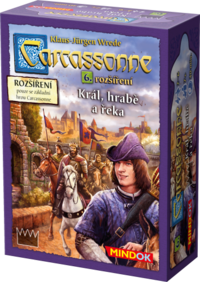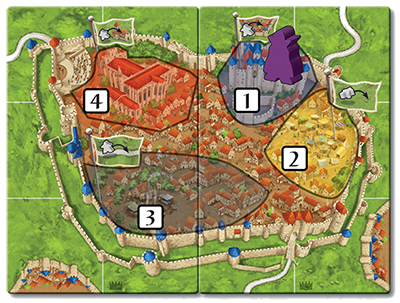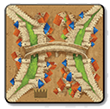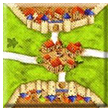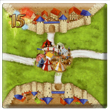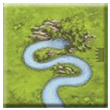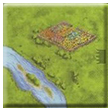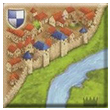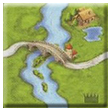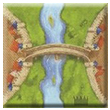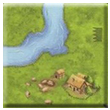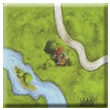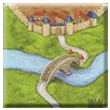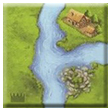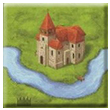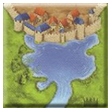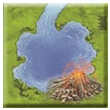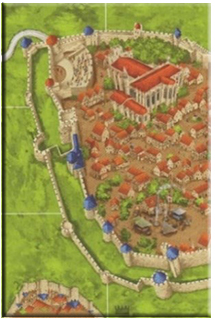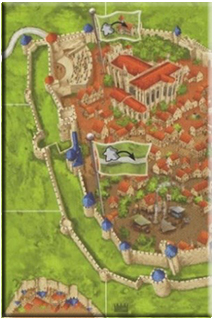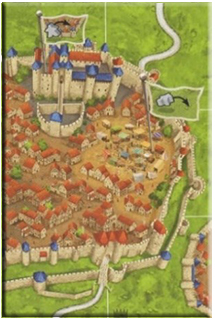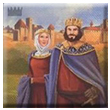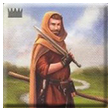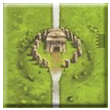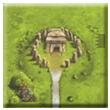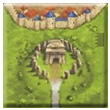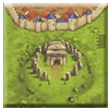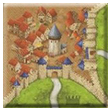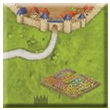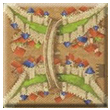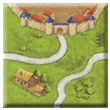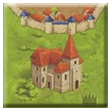Král, hrabě a řeka
| Hlavní strana > Rozšíření druhé edice |
Úvod
The 1st Edition of Count, King and Robber was released in 2008. Originally, this expansion bundled a collection of several smaller expansions which had been independently released for the 1st Edition at different times (2003-2008). However, these minor expansions are only available for the new Edition as a bundle.
Toto rozšíření nelze hrát samostatně – budete potřebovat základní hru Carcassonne, do níž ho můžete začlenit úplně nebo i jen částečně. Toto rozšíření můžete také libovolně kombinovat se všemi ostatními rozšířeními hry Carcassonne.
This page contains all the information for this major expansion but the River II, that is described on a separate page dedicated to the New Edition River expansions.
Herní materiál
- 2 desky města (dohromady velké jako 12 standardních kartiček krajiny, s odlišnými prvky na lícové a rubové straně) – přiloženy vedle sebe představují město Carcassonne
- 1 dřevěná figurka hraběte
- 1 žeton Král, 1 žeton Loupeživý rytíř (dva žetony navíc slouží jako případná náhrada)
- 1 kartička Král
- 1 kartička Loupeživý rytíř
- 2 kartiček krajiny, z toho
- 5 kartiček Svatyně
- 5 standardních kartiček krajiny
- 12 kartiček Řeka II
Pravidla
Příprava hry
This expansion offers two different ways to start the game: instead of using the standard start tile or the River I, you can either use the two large City tiles to form the city of Carcassonne or the River II as your starting point. Other than changing which tile is placed first, these options have no impact on gameplay. In both cases, return the standard start tile to the box before starting setup.
Do not use both The River II and The Count of Carcassonne. Combining the two can lead to situations where the river cannot be completed. [1]
Řeka II
Podrobnosti o tomto minirozšíření jsou zahrnuty na samostatné stránce Řeka. Nicméně některé související informace jsou pro úplnost zařazeny také sem.
Hrabě z Carcassonne
Příprava hry
Nejprve vyložte doprostřed stolu obě desky města tak, aby na sebe navazovaly odpovídající strany. Z jedné strany je vyznačeno město s vlajkami, z druhé bez vlajek. Chcete-li pouze mít místo startovní kartičky ve hře velké město, použijte stranu bez vlajek. Chcete-li hrát kompletní rozšíření, použijte stranu s vlajkami.
Na ní jsou ve městě vymezeny jednotlivé čtvrti, které mají důležitý význam: # Zámek # Tržiště # Kovárna # Katedrála
Začínající hráč postaví figurku hraběte do zámku a začne hru.
1. Přiložení kartičky
Přikládáte-li kartičku k desce města, musí terén navazovat jako obvykle a přikládaná kartička musí respektovat rastr na desce vymezený bílými čarami.
2. Umístění družiníka do města Carcassonne
Vždy, když ve svém tahu způsobíte přidělování bodů (ve fázi 3. Započítání bodů, [2] a některý ze soupeřů alespoň jeden bod získá, zatímco vy nezískáte žádný, [3] smíte umístit jednu figurku ze své zásoby do libovolné čtvrti v městě Carcassonne (i když se v této čtvrti nachází hrabě). [4] Kromě toho smíte navíc přemístit figurku hraběte do libovolné čtvrti města Carcassonne.
Pokud přiložením kartičky došlo k uzavření více území najednou, nesmíte získat žádné body při vyhodnocení žádného z nich, abyste tuto možnost směli využít. V jednom tahu smíte umístit do města Carcassonne maximálně 1 svou figurku. [5]
Opata můžete umístit pouze do katedrály ve městě Carcassonne.
3. Přemístění figurky z města při započítávání bodů
Je-li v průběhu hry uzavřeno nějaké území (město, cesta, klášter nebo svatyně), smí každý hráč ještě před přidělením bodů přemístit svou figurku či figurky z příslušné čtvrti města Carcassonne do tohoto právě uzavřeného a vyhodnocovaného území. [6] [7]
Z jednotlivých čtvrtí lze přemísťovat figurky takto:
Výjimka: ze čtvrti, kde se nachází figurka hraběte, není dovoleno přemísťovat žádné figurky. Jsou v této čtvrti blokovány, dokud není figurka hraběte přemístěna do jiné čtvrti. Hrabě stojí vždy v právě jedné čtvrti a město Carcassonne nemůže nikdy opustit.
Přesný průběh:
Uzavře-li hráč na tahu určité území, smí jako první přemístit své figurky z příslušné čtvrti města Carcassonne jeho spoluhráč po levici, po něm následují ostatní ve směru hodinových ručiček a nakonec smí své figurky přemístit aktivní hráč (hráč na tahu, jenž dané území uzavřel). Každý hráč může přemístit z příslušné čtvrti libovolný počet svých figurek. Teprve poté se provede vyhodnocení uzavřeného území [8] [9] a všechny figurky z něj se vrátí do zásoby příslušných hráčů.
![]() Otázka: Until now it was impossible to deploy a second monk to a monastery...
Otázka: Until now it was impossible to deploy a second monk to a monastery...
Odpověď: That is exactly the point. There was no rule that said only one monk could occupy a monastery. It was simply not possible because of the rules for placing tiles. This is the first opportunity for stealing a monastery away from a player. [10] And deploying the large meeple to a monastery may now be worthwhile as well.
Figurky, které se příslušný hráč rozhodne ponechat ve městě Carcassonne, zůstávají v příslušné čtvrti dál. Výše popsaný postup je jediný způsob, jak se figurky z města Carcassonne mohou ve hře použít. Není dovoleno je brát zpět do své zásoby.
Konec hry
Z tržiště je možné přemístit figurky před závěrečným vyhodnocením na konci hry na louky.Soused po levici hráče, který přiložil poslední kartičku a ukončil tak hru, začne. Jako první smí přemístit jednu svou figurku z tržiště na libovolnou louku. Po něm následují ostatní hráči ve směru hodinových ručiček, každý smí opět přemístit po jedné své figurce na libovolnou louku. Tak se pokračuje tak dlouho, dokud nejsou přemístěny všechny figurky z tržiště. Poté se louky vyhodnotí jako obvykle. Figurky, které zbydou na konci hry v jiných čtvrtích města, nepřinesou body žádné.
During final scoring, any meeples left in the other districts do nothing. [11] The city of Carcassonne counts as a city worth 3 points in its field.
Oficiální varianta [12]
I šlechta podléhá určitým pravidlům a nemůže si jednoduše dělat, co se jí zlíbí. Následující varianty to zohledňují a omezují svobodu hraběte. Použití těchto variant poskytne ještě více taktických možností. V obou variantách se již hrabě nemůže volně pohybovat, ale naopak:
- kdykoli je do města Carcassonne umístěn nový družiník, přesune se hrabě po směru hodinových ručiček do další městské čtvrti, nebo
- hrabě se přesune do té městské čtvrti, do které je umístěn nový družiník.
Král a Loupeživý rytíř
Příprava hry
Před zahájením partie připravte na vhodné místo na stole kartičky Král a Loupeživý rytíř i s oběma příslušnými žetony.
3. Započítání bodů
Král
Jakmile je během partie uzavřeno první město, obdrží příslušný hráč kartičku Král a žeton položí na toto uzavřené město (přitom je jedno, zda zároveň získal nějaké body, nebo ne). Uzavře-li později někdo větší město (tj. rozkládající se na více kartičkách), [13] převezme si kartičku Král on (či si ji ponechá nadále) a žetonem označí toto větší uzavřené město. Žeton Král tedy leží vždy na největším uzavřeném městě. Držitel kartičky Král na konci hry obdrží 1 bod za každé uzavřené město na herním plánu (město Carcassonne se také počítá).
Loupeživý rytíř
… funguje úplně stejně, ale na cestách. Držitel kartičky Loupeživý rytíř na konci hry získá 1 bod za každou uzavřenou cestu na herním plánu. [14]
Konec hry
Pokud máte při závěrečném vyhodnocení kartičku Krále, získáváte 1 bod za každé dokončené město (město Carcassonne se také počítá jako jedno dokončené město).
Pokud máte při závěrečném vyhodnocení kartičku Loupeživého rytíře, získáte 1 bod za každou dokončenou cestu.
Domácí pravidla
- At game end, use a lot of dice, place them on the board as completed features are found. Then collect them in, counting as you go. (Thanks to viberunner)
- Place unused pieces (or other objects) on the scoreboard to represent the size of the biggest city and the longest road. (Thanks to RationalLemming)
- Place the King and Robber markers on the scoreboard to represent the size of the biggest city and the longest road. (Thanks to Meepledrone)
- The player holding the King or Robber tile at the end of the game receives a straight 10 points for each card. This matches the points awarded for trade goods, and avoids having to count the number of completed roads and cities. (Thanks to Joff)
- The player holding the King or Robber tile at the end of the game receives a straight 15 points for each card, or 40 points if both cards are held by one player. (Thanks to PreGy)
- The player who completes the first road receives the Robber tile and keeps it until another player completes a larger road. Until that time, the player receives 1 bonus point every time a road is completed. The same applies for the King tile and cities. (Thanks to dustyu)
Svatyně
Preparation
Shuffle the five Shrine tiles with the other Land tiles.
1. Placing a tile
Shrine tiles cannot be placed adjacent to more than one monastery, and monasteries cannot be placed adjacent to more than one shrine. Shrine tiles are otherwise placed normally.
2. Placing a meeple as a heretic
When you place a shrine, you can place your meeple normally, or you can place a meeple as a heretic on the shrine. If you place a heretic adjacent to a monk, both meeples challenge each other (challenges are described below in 3. Scoring a feature). It is possible for two of your own meeples to challenge each other.
Otherwise, the shrine behaves like a monastery. You can place your abbot on the Shrine.
3. Scoring a feature
A shrine is scored when it is surrounded by other tiles. A completed shrine is worth 9 points. In case of a challenge, the first completed feature is worth 9 points. The other feature, when it is completed, is worth 0 points. If both features are completed at the same time, both are worth 9 points. In all cases, both the monk and the heretic are returned to their respective supplies. Meeples in the cathedral may be removed and placed on a shrine when it is completed.
![]() Otázka: Say I have a heretic engaged in a challenge with another player's monk, and I place the tile which completes the monk's monastery, so that the monk scores 9 points and I score 0. Can I still move a meeple to the city of Carcassonne in this case?
Otázka: Say I have a heretic engaged in a challenge with another player's monk, and I place the tile which completes the monk's monastery, so that the monk scores 9 points and I score 0. Can I still move a meeple to the city of Carcassonne in this case?
Odpověď: Yes, triggered scoring, received no points: conditions fulfilled.
Final Scoring
At the end of the game, any unresolved challenges (i.e., incomplete monasteries and shrines) are ignored. All players involved score points for their incomplete monasteries and shrines as normal.
House rules
- One could allow the placement of several neighboring shrines or monasteries into an area as long as no meeples are placed on those monasteries/shrines (i.e. there are no further challenges). A monk or heretic may not be involved in more than one challenge at a time.
New land tiles
Preparation
Shuffle the five new Land tiles with those from the base game and stack them normally.
| The tile to the right shows two city segments: one goes from the top to the bottom of the tile, while the other goes from left to right, across the bridge. |
Other expansions
The city of Carcassonne and the count of Carcassonne
- The following figures can be placed in a district of the city of Carcassonne:
- Normal meeple, the standard option (Base game)
- Abbot, only in the cathedral (Base game - The Abbot)
- Large meeple (Exp. 1 - Inns and Cathedrals)
- Wagon, not in the market (Exp. 5 - Abbey & Mayor)
- Mayor, only in the castle (Exp. 5 - Abbey & Mayor)
- Ringmaster (Exp. 10 - Under the Big Top)
- Phantom (The Phantom)
- Exp. 2 - Traders and Builders:
- If you take a double turn with the builder, you can place a meeple in the city of Carcassonne during both turns.
- Closing a city with trade goods is not does not stop you from sending a meeple to the city of Carcassonne.
![]() Otázka: If I complete a city with trade good but I score nothing, can I move a meeple to the city of Carcassonne?
Otázka: If I complete a city with trade good but I score nothing, can I move a meeple to the city of Carcassonne?
Odpověď: Yes, that’s allowed. Only immediately scored points matter. It doesn't matter if the trade goods may score at the end of the game.
- Exp. 3 - The Princess and the Dragon:
- You cannot move the dragon or the fairy into the city of Carcassonne.
- The dragon can fly around the outside the city of Carcassonne, treating the landscape areas as normal tiles and eating any figures on those tiles. Meeples and the Count inside the city of Carcassonne are unaffected. (10/2012)
- You cannot move a meeple into the city of Carcassonne with a magic portal.
- Meeples can be deployed on features on the city of Carcassonne tiles outside the city of Carcassonne itself, for example through use of a magic portal. (1/2013)
- Exp. 4 - The Tower: You cannot capture meeples in the city of Carcassonne with a tower.
- Exp. 5 - Abbey & Mayor:
- You can move meeples from the cathedral district to an abbey, as an abbey has all of the characteristics of a monastery.
- The city of Carcassonne counts as a city when scoring a barn.
- The barn cannot be placed in the city of Carcassonne.
- If your barn placement or field connection triggers a field scoring in which you score no points but another player else does, you may place a meeple in the city of Carcassonne.
![]() Otázka: If I place a barn on a field on which another player has farmers, causing him/her to score while I score nothing, can I move a meeple to the city of Carcassonne?
Otázka: If I place a barn on a field on which another player has farmers, causing him/her to score while I score nothing, can I move a meeple to the city of Carcassonne?
Odpověď: Yes, that's allowed. Only immediately scored points matter. It doesn't matter that the barn is certain to score at the end of the game.
- If a barn placement or field connection triggers a field scoring, you may move meeples from the market in the city of Carcassonne to that field. Score that field as normal, and return all farmers in that field to their respective supplies. (It doesn't matter that the barn is certain to score at the end of the game.)
![]() Otázka: Are the meeples in the market district only used at the end of the game?
Otázka: Are the meeples in the market district only used at the end of the game?
Odpověď: This is no longer entirely true. Placing of a barn, and the subsequent scoring of the field, does count as an opportunity to remove a meeple from the city of Carcassonne. Now that fields can be scored at times other than at the end of the game, meeples from the market can be moved to fields earlier in the game. That occurs immediately after the placement of the barn, and before the fields are scored. [Joining of a farm containing a meeple to a field with a barn would logically be another opportunity – Chris O.]
- You can move meeples from the market district to a field with a barn (and score it) if a field scoring is triggered. This can happen in the following cases:
- Placing a barn with farmer scoring: each completed city is worth 3 points
- Connecting a barn-less field to one with a barn: each completed city is worth 1 point
- At the end of the game, when preparing for final scoring: each completed city is worth 1 point (it is considered a special case of connecting fields)
- Please see the full scoring summary for these cases here (Exp. 5 - Abbey and Mayor).
- You can move meeples from the market district to a field with a barn (and score it) if a field scoring is triggered. This can happen in the following cases:
![]() Otázka: Can a meeple be moved from the city of Carcassonne to a field with a barn?
Otázka: Can a meeple be moved from the city of Carcassonne to a field with a barn?
Odpověď: Yes, the farmer will be scored immediately, and so scores only 1 point per city and is (importantly) not on the field during the final scoring proper. [Obviously, placement of a meeple in this manner still requires a scoring trigger as per the fundamental rules – this could be at the end of the game or with joining of a barnless field to one with a barn – Chris O.]
- Exp. 8 - Bridges, Castles and Bazaars: Meeples from the city of Carcassonne (the castle district) cannot move to a castle, as it is not a city anymore, but a new type of feature instead.
- Exp. 9 - Hills & Sheep:
- You cannot place your shepherd in the city of Carcassonne.
- You may deploy a meeple from from the city of Carcassonne on a hill tile with a feature about to be evaluated. [15] If you do, you gain the benefit of the hill.
- The Abbot: Gardens are not mentioned as a possible destination from the cathedral district. This omission leads to the conclusion that abbots cannot be redeployed from the City of Carcassonne to a garden.
- Mini #1 - The Flier (Flying Machines):
- You cannot move a meeple into the city of Carcassonne with a flying machine.
- Meeples can be deployed on features on the city of Carcassonne tiles outside the city of Carcassonne itself, for example through use of a flier. (1/2013)
- Besiegers - Cathars - Siege:
- A knight cannot escape a besieged city and be sent to the city of Carcassonne in the same turn. The turn sequence does not allow this because meeples are sent to the city of Carcassonne before knights can escape.
![]() Otázka: Can a player allow a meeple to escape a besieged city via a monastery, and place the same meeple in the city of Carcassonne on the same turn? (When does meeple escape happen?)
Otázka: Can a player allow a meeple to escape a besieged city via a monastery, and place the same meeple in the city of Carcassonne on the same turn? (When does meeple escape happen?)
Odpověď: The knight escapes at the end of the turn, and so cannot be re-deployed in the same turn. (5/2007)
- The Plague: As per interpretations regarding placement of the dragon and meeples on features outside the city of Carcassonne, it seems that the plague should also be allowed on the outside portion of these tiles. However, this is unofficial. (1/2013)
- Monasteries in Germany - Monasteries - 1st. Edition Monasteries in Germany / The Netherlands & Belgium:
- A meeple can be moved from the cathedral district to a German monastery (or any equivalent feature) placed as a monk (not an abbot), because the feature was only finished for scoring as a monastery. (6 & 10/2014)
- In this case the monastery has to be unoccupied or occupied by one monk at least (no matter the presence of other meeples placed as abbots). A monastery cannot be completed if occupied only by meeples placed as abbots.
- A meeple cannot be moved from the cathedral district to a German monastery (or any equivalent feature) placed as an abbot (that is, one with the special German monastery function that will be scored only at the end of the game). (6 & 10/2014)
- A meeple can be moved from the cathedral district to a German monastery (or any equivalent feature) placed as a monk (not an abbot), because the feature was only finished for scoring as a monastery. (6 & 10/2014)
King
- Exp. 1 - Inns and Cathedrals: The king does not score bonus points for a cathedral in a completed city.
- Exp. 8 - Bridges, Castles and Bazaars: A castle does not count as a completed city for the king.
- The Markets of Leipzig: The city of Leipzig should be counted as a completed city.
Robber
- Exp. 1 - Inns and Cathedrals:
- The robber does not score bonus points for an inn on a completed road.
- The short roads on one of the CRCR tiles of this expansions should not be considered for the Robber Baron bonus, since they cannot be occupied or scored.
- Exp. 5 - Abbey & Mayor: With the three-way tile, the length of the road is the total number of tiles in the road, not simply the longest distance between two ends. The road has three ends which have to be closed, but the result is that it’s likely to be bigger.
- The Festival: The short roads on the CRCR tile of this expansions should not be considered for the Robber Baron bonus, since they cannot be occupied or scored.
- The Labyrinth: With four-way tiles, the length of the road is the total number of tiles in the road, not simply the longest distance between two ends. The labyrinth has four ends which have to be closed, but the result is that it’s likely to be bigger.
The cultists
- You can occupy a shrine with the following figures:
- Normal meeple, the standard option (Base game)
- Abbot (Base game - The Abbot) [16]
- Large meeple (Exp. 1 - Inns and Cathedrals)
- Wagon (Exp. 5 - Abbey & Mayor)
- Ringmaster (Exp. 10 - Under the Big Top)
- Phantom (The Phantom)
- A challenge between a monk and a heretic can be triggered by other other placement types besides direct placement on the features:
- Placing a monk or a heretic with a magic portal (Exp. 3 - The Princess and the Dragon)
- Placing a monk or a heretic with a flying machine (Mini #1 - The Flier (Flying Machines))
- A challenge between a monk and a heretic will end if any of the figures is removed form its feature due to interactions with other expansions:
- The dragon eats one of them or both (Exp. 3 - The Princess and the Dragon)
- A tower captures one of them (Exp. 4 - The Tower)
- Any of them is knocked out by the catapult (Exp. 7 - The Catapult)
- The Plague/Pestilence/Pest action of the Wheel of Fortune removes any of them (The Wheel of Fortune)
- Any of them is removed when resolving Message 8 (Mini #2 - The Messages (Dispatches))
- A festival tile removes one of them (The Festival)
- The Vodyanoy tile traps any of them (Russian Promos)
- Any of them is an abbot and it is removed and scored (Base game - The Abbot)
- Exp. 3 - The Princess and the Dragon:
- Placing a tile with a magic portal that completes two features involved in a challenge does not allow you to place a meeple on one of them if unoccupied.
![]() Otázka: Imagine I have an unoccupied monastery next to an occupied shrine. I place a tile with a magic portal which completes both buildings, and choose to use the magic portal to deploy a monk to the monastery. Does this declare a challenge, and if so, who wins?
Otázka: Imagine I have an unoccupied monastery next to an occupied shrine. I place a tile with a magic portal which completes both buildings, and choose to use the magic portal to deploy a monk to the monastery. Does this declare a challenge, and if so, who wins?
Odpověď: This is actually an invalid placement of the meeple – the magic portal cannot be used to place a meeple on a completed feature (and the monastery is considered completed before the Move Wood phase). Thus, there can be no challenge, and the heretic gets 9 points. (updated 7/2014)
- You can use a magic portal to occupy a uncompleted feature after losing a challenge and become unoccupied.
![]() Otázka: When a challenge is resolved, both the monk and heretic are removed from play. If that leaves one of the features incomplete, can it be occupied again?
Otázka: When a challenge is resolved, both the monk and heretic are removed from play. If that leaves one of the features incomplete, can it be occupied again?
Odpověď: Yes, it can be reoccupied by using a magic portal or a meeple from Carcassonne.
- During a challenge, if a feature is completed, but the corresponding meeple is removed by the dragon, there is no evaluation for the monastery or shrine. With the "disappearance" of the monk or heretic, the challenge ends and the other remains on the landscape until his monastery or shrine is closed or removed from the landscape.
- A magic portal also allows you to trigger a challenge between a monastic building and a shrine, since these are areas of the landscape on tiles that were placed by the players during the game, and on which a meeple could also have been placed normally.
- The fairy can be assigned to a heretic.
- Exp. 5 - Abbey & Mayor:
- A monk in an abbey can challenge a heretic in a shrine (and vice versa).
- The rules that restrict the placement of monasteries next to already placed shrines (and vice versa) also restrict the placement of abbeys.
- Exp. 6 - Count, King and Robber:
- If you lose a challenge, you can move a meeple to the city of Carcassonne.
![]() Otázka: Say I have a heretic engaged in a challenge with another player's monk, and I place the tile which completes the monk's monastery, so that the monk scores 9 points and I score 0. Can I still move a meeple to the city of Carcassonne in this case?
Otázka: Say I have a heretic engaged in a challenge with another player's monk, and I place the tile which completes the monk's monastery, so that the monk scores 9 points and I score 0. Can I still move a meeple to the city of Carcassonne in this case?
Odpověď: Yes, triggered scoring, received no points: conditions fulfilled.
- Exp. 9 - Hills & Sheep: Vineyard rules are the same for shrines as they are for monasteries.
- Mini #1 - The Flier (Flying Machines):
- Placing a tile with a flying machine that completes two features involved in a challenge does not allow you to place a meeple on one of them if unoccupied.
- You can use a flying machine to occupy a uncompleted feature after losing a challenge and become unoccupied.
- A flying machine also allows you to trigger a challenge between a monastic building and a shrine, since these are areas of the landscape on tiles that were placed by the players during the game, and on which a meeple could also have been placed normally.
- Besiegers - Cathars - Siege: A knight in a besieged city from can escape via a shrine, as with a monastery. The shrines are, for the most part, identical to monasteries. That goes for escape as well.
- Monasteries in Germany - Monasteries - 1st. Edition Monasteries in Germany / The Netherlands & Belgium:
- A meeple placed on a German monastery (or any equivalent feature) as a monk can be involved in a challenge with a heretic.
- A meeple placed on a German monastery (or any equivalent feature) as an abbot cannot be involved in a challenge with a heretic, as the two scoring mechanisms are entirely different (the abbot’s feature is never completed, so the heretic would always win.) (5/2014)
Tile distribution
The River II
Total tiles: 12
Several tiles have a small illustration on them. The letters in brackets show which illustration is on each tile:
Additionally, some tiles present additional features indicated in bold, some proper of River II (source, fork, and lake), some others serving as tie-in with other expansions (inn, pig-herd, and volcano.)
Count of Carcassonne
Total tiles: 2 (2x3 tiles)
King and robber
Total tiles: 2
Total markers: 2
Two spare markers are included.
Cultists
Total tiles: 5
Several tiles have a small illustration on them. The letters in brackets show which illustration is on each tile:
New land tiles [17]
Total tiles: 5
Některé kartičky obsahují dodatečné ilustrace, které mohou mít význam v kombinaci s některým z dalších rozšíření. Označení písmeny ponecháváme v původním znění:
Poznámky pod čarou
Vysvětlení ikonek najdete na této stránce.
- ↑
 Despite this rule from the New Edition, the latest rules for the 1st. Edition of The River II stated that "if you decide to use The Count of Carcassonne and The River II as starting tiles for a game, it is possible that one will not be able to use all of the river tiles if they are placed too close to the city of Carcassonne. River tiles which cannot be placed should be removed from the game, in accordance with the basic rules. Even if the river cannot be placed in its entirety, the game should proceed in the usual way." See the comments in 1st. Edition Rivers page for more information.
Despite this rule from the New Edition, the latest rules for the 1st. Edition of The River II stated that "if you decide to use The Count of Carcassonne and The River II as starting tiles for a game, it is possible that one will not be able to use all of the river tiles if they are placed too close to the city of Carcassonne. River tiles which cannot be placed should be removed from the game, in accordance with the basic rules. Even if the river cannot be placed in its entirety, the game should proceed in the usual way." See the comments in 1st. Edition Rivers page for more information.
- ↑
 V pravidlech ZMG a Mindokuje tento odkaz na fázi, vynechán. Tato podmínka vylučuje bodování v jiných fázích.
V pravidlech ZMG a Mindokuje tento odkaz na fázi, vynechán. Tato podmínka vylučuje bodování v jiných fázích.
- ↑
 It is clear from the wording that only scoring caused by placement of a tile can trigger placement of a meeple in Carcassonne. Thus, scoring from non-landscape-tile related events (such as from dispatches (Messages, The (Dispatches) or paying a ransom for the tower (The Tower)) would not trigger meeple placement. Interestingly, though, the placement of a barn (Abbey & Mayor) does trigger the ability to place a meeple in the city of Carcassonne, only if you do not receive points, but somebody else does.
It is clear from the wording that only scoring caused by placement of a tile can trigger placement of a meeple in Carcassonne. Thus, scoring from non-landscape-tile related events (such as from dispatches (Messages, The (Dispatches) or paying a ransom for the tower (The Tower)) would not trigger meeple placement. Interestingly, though, the placement of a barn (Abbey & Mayor) does trigger the ability to place a meeple in the city of Carcassonne, only if you do not receive points, but somebody else does.
- ↑
 V pravidlech HiG a Mindoku tuto závorku neobsahují. Závorka je pouze v pravidlech ZMG.
V pravidlech HiG a Mindoku tuto závorku neobsahují. Závorka je pouze v pravidlech ZMG.
- ↑
 V pravidlech ZMG je omezení o nemožnosti získat body z žádné dokončené funkce vynecháno. To by hráčům umožnilo poslat družiníka do města Carcassonne, když neobdrží body alespoň za jedno území z mnoha bodovaných.
V pravidlech ZMG je omezení o nemožnosti získat body z žádné dokončené funkce vynecháno. To by hráčům umožnilo poslat družiníka do města Carcassonne, když neobdrží body alespoň za jedno území z mnoha bodovaných.
- ↑
 Družiníky ve městě Carcassonne lze' přemístit na prázdné cesty, města, kláštery nebo louky. Po dokončení prázdné cesty, města nebo kláštera mohou být meeply v příslušné čtvrti města [meeply na hradě lze rozmístit pouze do měst a tak dále] přemístěny a poté okamžitě bodovány. Obecně platí, že neobsazená města, silnice a kláštery nepřinášejí příliš mnoho bodů, a tak je tato možnost užitečná hlavně při vracení meeples z města Carcassonne do zásoby hráče.
Družiníky ve městě Carcassonne lze' přemístit na prázdné cesty, města, kláštery nebo louky. Po dokončení prázdné cesty, města nebo kláštera mohou být meeply v příslušné čtvrti města [meeply na hradě lze rozmístit pouze do měst a tak dále] přemístěny a poté okamžitě bodovány. Obecně platí, že neobsazená města, silnice a kláštery nepřinášejí příliš mnoho bodů, a tak je tato možnost užitečná hlavně při vracení meeples z města Carcassonne do zásoby hráče.
- ↑
 Hráč, který dokončí silnici, město nebo klášter, ale bez zisku, nemůže rozmístit meeple do města Carcassonne a znovu rozmístit dalšího před bodováním oblasti. Nejprve se provede bodování a teprve poté, pokud se naskytne příležitost, může být meeple nasazen do města Carcassonne. Pokud hráč použije meepla, který se již nachází ve městě Carcassonne, pak profituje z bodování a nemůže do města Carcassonne přesunout dalšího meepla.
Hráč, který dokončí silnici, město nebo klášter, ale bez zisku, nemůže rozmístit meeple do města Carcassonne a znovu rozmístit dalšího před bodováním oblasti. Nejprve se provede bodování a teprve poté, pokud se naskytne příležitost, může být meeple nasazen do města Carcassonne. Pokud hráč použije meepla, který se již nachází ve městě Carcassonne, pak profituje z bodování a nemůže do města Carcassonne přesunout dalšího meepla.
- ↑
 This implies that majority is computed taking into account the meeples just redeployed from the city of Carcassonne, if any.
This implies that majority is computed taking into account the meeples just redeployed from the city of Carcassonne, if any.
- ↑
 Meeples in the city of Carcassonne are not scored. However, the meeples can influence the usual scoring, as players can redeploy their figures to any city, road, cloister, or field that is currently being scored.
Meeples in the city of Carcassonne are not scored. However, the meeples can influence the usual scoring, as players can redeploy their figures to any city, road, cloister, or field that is currently being scored.
- ↑
 A monastery with multiple monks from various players will be scored taking into account the majority, the same as a road or a city. This will also apply to all monastic features: monasteries, abbeys, shrines, German monasteries, Dutch & Belgian monasteries, Japanese buildings and Darmstadt churches.
A monastery with multiple monks from various players will be scored taking into account the majority, the same as a road or a city. This will also apply to all monastic features: monasteries, abbeys, shrines, German monasteries, Dutch & Belgian monasteries, Japanese buildings and Darmstadt churches.
When dealing with special monasteries (German monasteries, Dutch & Belgian monasteries and Japanese buildings), you may place additional meeples as abbots with a flying machine. You won't be allowed to deploy meeples as abbots from the city of Carcassonne.
Meeples placed as abbots on a special monastery will be ignored if the feature is completed and scored by any meeples placed as monks on the feature. However, those meeples placed as abbots will be scored at the end of the game, taking into account the majority if more than one player has meeples on the feature. - ↑
 This limitation didn't exist in the 1st Edition. It overrides the latest clarification regarding this point:
This limitation didn't exist in the 1st Edition. It overrides the latest clarification regarding this point:
Question: How does follower placement during the final scoring work? Answer: In principle very similarly to the way it works during the game. The 'trigger' for the final scoring is the player who placed the last tile and so ended the game. Beginning with the player on the left of the 'trigger' player, each player redeploys one of his or her followers from Carcassonne to an appropriate feature [followers in castle can only be deployed to cities, and so on] on the board. Followers can also be redeployed to incomplete roads, cities, cloisters, or farms, since these will also be scored at the end of the game. This process continues until no player can redeploy any more players from Carcassonne. The Count still blocks the city quarter in which he is resident. Normally the player with the most followers in Carcassonne will be the one to redeploy the last figure. - ↑
 Tyto varianty byly zveřejněny na stránkách HiGjak uvádí Matthew Harper v tomto příspěvku na BGG v roce 2005:
https://boardgamegeek.com/thread/73808/official-variants-hans-im-gluck
Tyto varianty byly zveřejněny na stránkách HiGjak uvádí Matthew Harper v tomto příspěvku na BGG v roce 2005:
https://boardgamegeek.com/thread/73808/official-variants-hans-im-gluck
- ↑
 Hráč, který během hry dokončí největší město, tj. město, které se skládá z nejvíce kartiček krajiny, získá kartičku krále. Ne vždy tedy může získat kartičku Krále město s největším počtem bodů, například menší město získá více bodů díky penále nebo katedrále.
Hráč, který během hry dokončí největší město, tj. město, které se skládá z nejvíce kartiček krajiny, získá kartičku krále. Ne vždy tedy může získat kartičku Krále město s největším počtem bodů, například menší město získá více bodů díky penále nebo katedrále.
- ↑
 Hráč, který během hry dokončí nejdelší cestu, tedy cestu, která se skládá z nejvíce kartiček krajiny, získá kartičku Loupeživého rytíře. Nejvíce bodů získávající cesta tedy nemusí vždy vyhrát kartičku Loupeživého rytíře, například menší cesta získá více bodů díky hostincům.
Hráč, který během hry dokončí nejdelší cestu, tedy cestu, která se skládá z nejvíce kartiček krajiny, získá kartičku Loupeživého rytíře. Nejvíce bodů získávající cesta tedy nemusí vždy vyhrát kartičku Loupeživého rytíře, například menší cesta získá více bodů díky hostincům.
- ↑
 We updated this sentence according to the German rules. The rules by ZMG contain a mistranslated version of this sentence: "You can place one meeple from the city of Carcassonne on a hill tile with a feature that has not been completed."
We updated this sentence according to the German rules. The rules by ZMG contain a mistranslated version of this sentence: "You can place one meeple from the city of Carcassonne on a hill tile with a feature that has not been completed."
- ↑
 This clarification is included in the rules by HiG but omitted by ZMG.
This clarification is included in the rules by HiG but omitted by ZMG.
- ↑
 These 5 tiles were part of King & Robber in the Carcassonne I edition.
These 5 tiles were part of King & Robber in the Carcassonne I edition.
